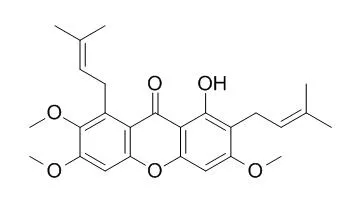| In vitro: |
| Planta Med. 2005 Feb;71(2):181-3. | | Cytotoxic constituents from Cratoxylum arborescens.[Pubmed: 15729629 ] | A new natural xanthone, 1,3-dihydroxy-6,7-dimethoxy-2,8-diprenylxanthone, together with four known compounds, Fuscaxanthone C, 1,7-dihydroxyxanthone, 3-geranyloxy-6-methyl-1,8-dihydroxyanthraquinone and 2-geranylemodin were isolated from the stem bark of Cratoxylum arborescens (Vahl) Blume.
METHODS AND RESULTS:
The structure elucidations were achieved through spectroscopic analyses. Compounds 1 and 5 showed moderate activity against the human small cell lung cancer NCI-H187 cell line with the IC50 values of 3.69 +/- 1.27 microg/mL and 3.08 +/- 0.73 microg/mL, respectively. | | Research Journal of Chemistry & Environment, 2011 , 15 (2) :62-66. | | α-mangostin and β-mangostin from Cratoxylum glaucum[Reference: WebLink] | Our continuing interest in xanthones and anthraquinones from the Cratoxylum genus has led us to look at Cratoxylum glaucum. This resulted in the isolation of α-mangostin (1), β-mangostin (2), Fuscaxanthone C (3), 3-geranyloxy-6-methyl-l, 8-dihydroxyanthraquinone (4), β-sitosterol (5), 1, 8-dihydroxy-3-methoxy-6-methylanthraquinone (6), stigmasterol (7), friedelin (8) and betulinic acid (9).
METHODS AND RESULTS:
Structural elucidations of these compounds were achieved by using ID and 2D NMR spectroscopic experiments. Cytotoxic assays indicated that the hexane and ethyl acetate extracts demonstrated cytotoxicity against the MCF7 cancer cell line. Meanwhile, the ethyl acetate and methanol extracts of C. glaucum inhibited the HL-60 cancer cell line activity. |
|






 Cell. 2018 Jan 11;172(1-2):249-261.e12. doi: 10.1016/j.cell.2017.12.019.IF=36.216(2019)
Cell. 2018 Jan 11;172(1-2):249-261.e12. doi: 10.1016/j.cell.2017.12.019.IF=36.216(2019) Cell Metab. 2020 Mar 3;31(3):534-548.e5. doi: 10.1016/j.cmet.2020.01.002.IF=22.415(2019)
Cell Metab. 2020 Mar 3;31(3):534-548.e5. doi: 10.1016/j.cmet.2020.01.002.IF=22.415(2019) Mol Cell. 2017 Nov 16;68(4):673-685.e6. doi: 10.1016/j.molcel.2017.10.022.IF=14.548(2019)
Mol Cell. 2017 Nov 16;68(4):673-685.e6. doi: 10.1016/j.molcel.2017.10.022.IF=14.548(2019)